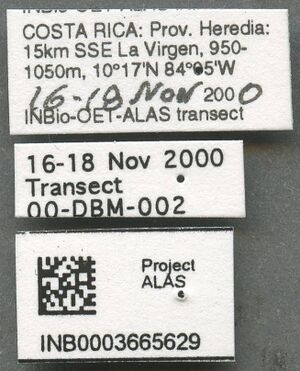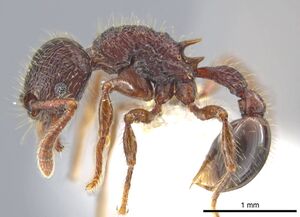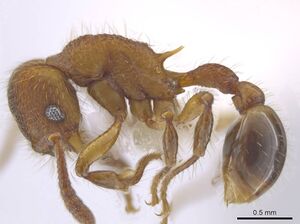Hylomyrma montana
| Hylomyrma montana | |
|---|---|

| |
| Scientific classification | |
| Kingdom: | Animalia |
| Phylum: | Arthropoda |
| Class: | Insecta |
| Order: | Hymenoptera |
| Family: | Formicidae |
| Subfamily: | Myrmicinae |
| Tribe: | Pogonomyrmecini |
| Genus: | Hylomyrma |
| Species: | H. montana |
| Binomial name | |
| Hylomyrma montana Peirce, Branstetter & Longino, 2017 | |
Hylomyrma montana is the first recorded species in the genus known to be exclusively restricted to cloud forest habitat (Peirce et al., 2017). Ulyssea & Brandao (2021) found this species inhabits wet forest sites at elevations between 29 and 1800 m. Specimens are frequently found in leaf-litter samples, which suggests that nests are located in leaf-litter, fallen logs, rotten wood, or inside natural cavities of the superficial soil layers. Except for the presence of intercastes, there is no further information available regarding the biology of H. montana.
Photo Gallery
Identification
Pierce et al. (2017) - Postpetiolar dorsum smooth and shining or weakly striate; eye relatively small (OI 21 - 24).
Ulyssea & Brandao (2021) - Regular and longitudinal striae on head dorsum diverge towards posterior margin, interspaces between thicker striae filled with thinner striae; regular and irregular striae on mesosoma assuming multiple directions, interspaces smooth; dorsal tooth of propodeal lobe acute, ventral tooth blunt; dorsal margin of mesosoma slightly discontinuous, somewhat straight (mesosoma slightly flattened dorsally), promesonotal junction and metanotal groove discernible by a slight depression (LV) and altered sculpture (DV); propodeal spine long; dorsal margin of petiole continuous, convex; ventral surface with transverse striae from petiole spiracle to posterior end of petiole; irregular, longitudinal and anastomosed striae node dorsum; postpetiole smooth; subpostpetiolar process predominantly smooth, weak, convex; profemur posterior surface and protibia extensor surface smooth; striation on tergum of first gastral segment restricted to base, very short striae.
This species is easily distinguished from almost all of its congeners, but it is very similar to Hylomyrma lispectorae regarding the shape of mesosoma, and the sculpture and shape of the procoxa, petiole, postpetiole, and gaster. The two species are sympatric, co-occuring in two Ecuadorian localities: Centro Científico Río Palenque, and 4 km E of Santo Domingo de los Colorados (Figs. 83, 84).
Hylomyrma montana can be distinguished from H. lispectorae (characteristic in parentheses) by the dorsum of head and mesosoma with irregular striae of uniform thickness with interspaces distinguishable (vs. vermicular striae of variable thickness with interspaces indistinguishable), and the somewhat straight dorsal margin of mesosoma (vs. notably convex).
The morphological variation displayed by H. montana is associated with the presence of intercastes. Three specimens have an inconspicuous central ocellus, and a more pronounced depression on the metanotal groove. Two specimens (#17842, #17840) from Chiriqui-Bocas del Toro, Panama, have more queen-like traits, as larger bodies [HL (1); HW (0.94–0.98); ML (0.58–0.62); SL (0.68–0.70); MOD (0.22–0.23); PNW (0.25–0.26); WL (1.32–1.34); PSL (0.30–0.31); PL (0.64–0.65); PW (0.25–0.26); PPL (0.36); PPW (0.35–0.38); GL (1.18–1.30); TL (5.09–5.26)], the presence of three ocelli, the well-marked promesonotal suture, the differentiated mesonotum (scutum, transcutal suture, prescutellum, and scutellum) and metanotum.
Keys including this Species
Distribution
Latitudinal Distribution Pattern
Latitudinal Range: 10.31241409° to -0.39506°.
| North Temperate |
North Subtropical |
Tropical | South Subtropical |
South Temperate |
- Source: AntMaps
Distribution based on Regional Taxon Lists
Neotropical Region: Costa Rica (type locality), Ecuador, Panama.
Distribution based on AntMaps
Distribution based on AntWeb specimens
Check data from AntWeb
Countries Occupied
| Number of countries occupied by this species based on AntWiki Regional Taxon Lists. In general, fewer countries occupied indicates a narrower range, while more countries indicates a more widespread species. |

|
Estimated Abundance
| Relative abundance based on number of AntMaps records per species (this species within the purple bar). Fewer records (to the left) indicates a less abundant/encountered species while more records (to the right) indicates more abundant/encountered species. |

|
Biology
Castes
Worker
             
| |
| . | |
Nomenclature
The following information is derived from Barry Bolton's Online Catalogue of the Ants of the World.
- montana. Hylomyrma montana Pierce, M.P., Branstetter, et al. 2017: 138, figs. 3, 4, 7 (w.) COSTA RICA, PANAMA, ECUADOR.
- Type-material: holotype worker, 12 paratype workers.
- Type-locality: holotype Costa Rica: Limón, Cerro Platano, 9.86732, -83.24131±20 m., 1130 m., 18.vi.2015, Wm-E-03-1-10 (project ADMAC); paratypes with same data.
- Type-depositories: CASC (holotype); MCZC, JTLC, UCDC, UCRS, USNM (paratypes).
- Ulysséa & Brandão, 2021: 85 (q.).
- Status as species: Ulysséa & Brandão, 2021: 83 (redescription).
- Distribution: Costa Rica, Ecuador, Panama.
Type Material
- Holotype worker: Costa Rica, Limón, Cerro Platano, 9.86732 - 83.24131 ± 20 m, 1130 m above sea level (a.s.l.), 18 June 2015 (Project ADMAC, collection code Wm-E-03-1-01) [CAS, unique specimen identifier CASENT0637306].
- Paratype workers (n = 12): same data as holotype Museum of Comparative Zoology, CASENT0638686; University of California, Davis, CASENT0638689; Universidad de Costa Rica, CASENT0638690; National Museum of Natural History, CASENT0638691; John T. Longino Collection, CASENT0638721, CASENT0638702, CASENT0638694, CASENT0638692, CASENT0638699, CASENT0638696, CASENT0638719, CASENT0638695].
Unless otherwise noted the text for the remainder of this section is reported from the publication that includes the original description.
Description
Worker
(holotype): EL 0.195, EW 0.134, GSL 0.065, HFL 0.796, HL 0.833, HW 0.845, ML 1.116, OMD 0.133, PpL 0.278, PpW 0.295, PronW 0.563, SL 0.676, SPL 0.282, CI 101, GSI 6, OI 23, PpWI 106, SI 80, SPI 33. Measurements (range, n = 20): EL 0.175 - 0.218, EW 0.124 - 0.149, GSL 0.047 - 0.123, HFL 0.775 - 0.945, HL 0.813 - 0.948, HW 0.804 - 0.899, ML 1.03 - 1.236, OMD 0.108 - 0.151, PpL 0.246 - 0.314, PpW 0.289 - 0.371, PronW 0.544 - 0.645, SL 0.621 - 0.742, SPL 0.248 - 0.329, CI 94 - 102, GSI 4 - 10, OI 21 - 24, PpWI 106 - 124, SI 75 - 83, SPI 31 - 39.
Head subquadrate; in full-face view sides and dorsum relatively straight, occipital corners rounded. Clypeus bidentate, denticles moderately long and projecting; clypeal margin between denticles slightly concave. Clypeus and frontal area rugose. Frontal lobes rather large, with convex sides projecting over antennal insertions. Head in full-face view densely longitudinally striatorugose. Rugae beginning at mandibular insertions and frontal lobes, and continuing uninterrupted to occipital margin, occasionally intersecting and forming a sub-reticulate pattern. Area between rugae micro-punctatostriate. Head with moderate pilosity, hairs golden in color and pointed at ends. Eye consisting of more than 40 facets, relatively short and distant from anterolateral margin of head. Antennal scapes rugose, curved, thinner towards antennal insertions and thicker towards apices. Pilosity of scapes consisting of suberect to erect hairs. Funicular segments of antennae gradually increasing in size, and covered with sub-erect hairs.
Mesosoma in profile view convex from neck to propodeal spines, profile interrupted by rugae. Sides of mesosoma densely reticulate-rugose, interrugal spaces micropunctatostriate, subopaque. Pronotal and metanotal grooves absent. In profile view, dorsum of mesosoma with long and pointed erect hairs. Propodeal spines medium sized and projecting over inferior propodeal plates.
Petiole elongated, lacking differentiated peduncle and node. Sides and dorsum of petiole rugose. Postpetiole in profile subquadrate; ventral surface flat, dorsal surface slightly convex. In dorsal view, postpetiole sub-triangular, sides flaring from anterior margin to posterior margin. Dorsal surface of postpetiole largely smooth and shining, with at most a few faint longitudinal costulae. Gaster largely smooth and shining. Tergum 1 of gaster with short longitudinal costulae, less than 0.1 mm in length, in some specimens nearly absent.
Overall body color dark reddish-brown. Legs and antennae somewhat lighter brown.
Etymology
The name is in reference to the montane distribution of the species.
References
- Peirce, M.P., Branstetter, M.G., Longino, J.T. 2017. Integrative taxonomy reveals multiple cryptic species within Central American Hylomyrma FOREL, 1912 (Hymenoptera: Formicidae). Myrmecological News 25, 131-143.
- Ulyssea, M.A., Brandao, C.R.F. 2021. Taxonomic revision of the Neotropical ant genus Hylomyrma Forel, 1912 (Hymenoptera: Formicidae: Myrmicinae), with the description of fourteen new species. Zootaxa 5055, 1–137 (doi:10.11646/zootaxa.5055.1.1).*Ulysséa, M.A., Farder-Gomes, C.F., Prado, L.P. 2024. Biological notes, nest architecture, and morphology of the remarkable ant Hylomyrma primavesi Ulysséa, 2021 (Hymenoptera: Formicidae: Myrmicinae). Myrmecological News 34, 1-20 (doi:10.25849/MYRMECOL.NEWS_034:001).
References based on Global Ant Biodiversity Informatics
- Longino J. T. L., and M. G. Branstetter. 2018. The truncated bell: an enigmatic but pervasive elevational diversity pattern in Middle American ants. Ecography 41: 1-12.
- Pierce M. P., M. G. Branstetter, and J. T. Longino. 2017 . Integrative taxonomy reveals multiple cryptic species within Central American Hylomyrma FOREL, 1912 (Hymenoptera: Formicidae). Myrmecological News 25: 131-143.



